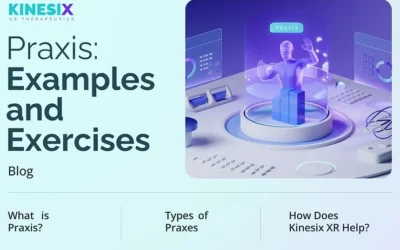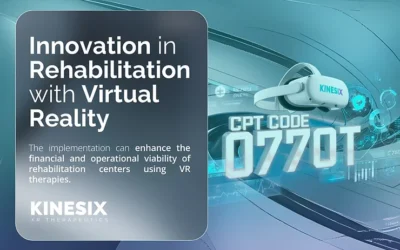Dynamic and static balance are critical skills enabling the efficient performance of daily and athletic activities, significantly impacting our quality of life and autonomy.
Dynamic balance ensures stability during movement, essential for activities like walking, running, or any motion-based task, while static balance is fundamental for maintaining controlled and steady posture without movement.
Virtual reality (VR) emerges as an advanced technology that enhances these balance skills through simulations that replicate real-world challenges in a safe environment.
This article by Kinesix VR explores how immersive virtual reality significantly aids in balance rehabilitation by combining visual and motor stimuli, fostering an integrated recovery of these vital skills.
Understanding Dynamic and Static Balance
Dynamic balance refers to the ability to maintain body control while in motion. This skill is essential not only for sports-related actions like running, jumping, or turning but also for daily activities such as climbing stairs, bending to pick something up, or walking on uneven surfaces.
Dynamic balance primarily involves a complex coordination of sensory and motor systems including the visual, vestibular (inner ear), and proprioceptive systems, which relate to the perception of motion and body position.
This integration allows individuals to react quickly and accurately to continuous changes in position and movement, adjusting their body to maintain stability.
On the other hand, static balance is the capacity to sustain a stable and controlled position without movement, which is fundamental for tasks like standing in line, sitting upright without support, or adopting specific postures in yoga or gymnastics.
Static balance is not merely the absence of movement; it is an active process where the body makes subtle, often imperceptible adjustments to maintain posture and orientation.
These adjustments rely on constant sensory and motor feedback to counter any shifts in the center of gravity, ensuring stability.
Both forms of balance are essential for effective functioning in our environment. Good dynamic and static balance translates to better quality of life as it empowers people to perform activities with greater safety, efficiency, and autonomy, especially for those recovering from conditions like strokes or spinal injuries.
Virtual Reality as a Balance Training Tool
Virtual reality (VR) is revolutionizing balance training by offering a versatile and effective tool adaptable to a wide range of needs.
Using simulated environments, VR provides an immersive experience that not only mimics motor challenges but also stimulates sensory integration, crucial for developing both dynamic and static balance.
For dynamic balance training, VR creates scenarios that require users to adapt to changes in the virtual environment, such as avoiding obstacles or following unpredictably changing routes.
These dynamic scenarios force the brain and body to collaborate, improving coordination, agility, and spatial awareness. VR programs designed for dynamic balance can adjust task difficulty, ensuring accessibility for beginners while challenging advanced users.
When it comes to static balance, virtual reality helps improve posture and stability through exercises that require users to hold specific positions or make minor adjustments to counter virtual challenges.
For instance, a VR program might simulate being on an unstable platform, requiring the user to stay upright without falling. This practice trains the body to perform precise, rapid postural adjustments, strengthening muscles and improving neuromuscular responses.
A key advantage of VR is its ability to provide instant, objective feedback. Combined with motion capture systems and analysis software, VR delivers visual, auditory, or tactile feedback to help users improve performance. This immediate feedback enhances body awareness and learning while motivating users to excel.
Additionally, VR transforms balance training into a more engaging and motivating experience. By gamifying exercises or incorporating interactive activities, users find rehabilitation and training to be less monotonous and more enjoyable. This increase in engagement often leads to improved adherence to training programs and better long-term outcomes.
Clinically, VR offers significant opportunities for personalized rehabilitation. It can simulate real-life scenarios that a patient may face, allowing for safe and controlled practice.
What’s more, VR’s capacity to customize settings based on individual needs and progress makes it an invaluable tool for healthcare professionals, who can design rehabilitation programs tailored specifically to each individual’s balance deficits.
Types of Balance and VR Exercises
Here are some examples of exercises and their contributions to improving balance skills, categorized by balance type.
Dynamic Balance
- Virtual Walks: VR programs simulate walks across various terrains, such as forest trails, beaches, or busy city streets. These environments challenge users to adapt their balance to different surfaces and obstacles, enhancing coordination and the ability to respond to unexpected changes.
- Navigation Challenges: These include navigating mazes or following dynamically changing routes. Such exercises encourage quick decision-making and enhance the ability to anticipate and adjust balance during movement.
- Simulated Sports Activities: Games imitating sports like skiing, surfing, or soccer require complex body movements and constant balance adjustments, which help strengthen muscles and improve dynamic stability.
Static Balance
- Postural Exercises: Holding different postures or performing yoga or tai-chi sequences in a virtual setting improves stability and focus. Activities can be adjusted for increased difficulty, such as unstable surfaces or visual distractions that challenge the ability to remain still.
- Balance Board Exercises: Programs simulating standing on a balance board or unstable platform require users to maintain their center of gravity. These exercises enhance fine postural adjustments and body awareness.
- Controlled Strength Training: VR-guided exercises that demand stability, such as squats or lunges, focus on maintaining correct posture. They help strengthen muscles essential for static balance.
These VR exercises are designed not only to improve dynamic and static balance but also to adapt to individual skills, physical limitations, and goals.
Kinesix VR and Balance Rehabilitation for Specific Conditions
Kinesix VR is an innovative technological solution in rehabilitation, tailored to improve balance in individuals recovering from conditions such as strokes, spinal injuries, and age-related issues.
This platform leverages virtual reality to create a safe and controlled environment for specific and personalized balance training.
Rehabilitation After Stroke
For stroke patients, regaining balance is crucial for restoring independence and enhancing quality of life. Kinesix VR offers targeted programs that help these patients improve both dynamic and static balance.
Through exercises simulating daily activities and specific challenges, patients can work on their ability to maintain and adapt their balance in various situations, enhancing neuromuscular coordination and sensory-motor responses.
Rehabilitation for Spinal Injuries
Patients with spinal injuries often face significant challenges in maintaining balance due to impaired motor and sensory functions. Kinesix VR helps these patients retrain their balance with exercises designed to strengthen trunk stability and the muscles supporting balance.
The VR system’s flexibility makes it accessible for severely affected patients, combining it with rigid or dynamic standing frames and weight-bearing systems as needed.
By providing an immersive training environment, Kinesix VR allows users to experience movements and postures that promote adaptability and muscular strength, essential for balance rehabilitation following spinal injuries.
Geriatric Balance Issues
In geriatric care, maintaining balance is vital to preventing falls—a common cause of injuries among older adults. Kinesix VR caters to this demographic with exercises that improve both dynamic and static balance.
Programs are designed to gradually increase effort and difficulty while maintaining a suitable challenge that accounts for physical limitations. They focus on enhancing stability and overall mobility, encouraging active participation through enjoyable, tailored activities. This approach contributes to sustained balance improvements and greater autonomy in daily activities.
With its personalized, state-of-the-art approach, Kinesix VR is a powerful tool for balance rehabilitation across diverse medical conditions. By combining virtual reality with targeted therapeutic exercises, Kinesix VR not only enhances physical balance but also supports neurological recovery and builds confidence in individuals facing significant mobility and stability challenges.





0 Comments